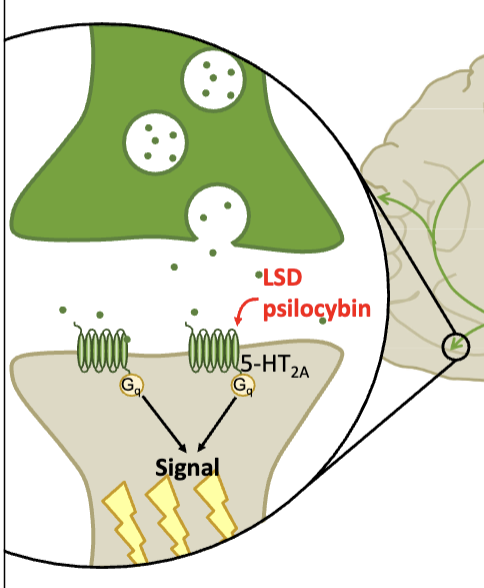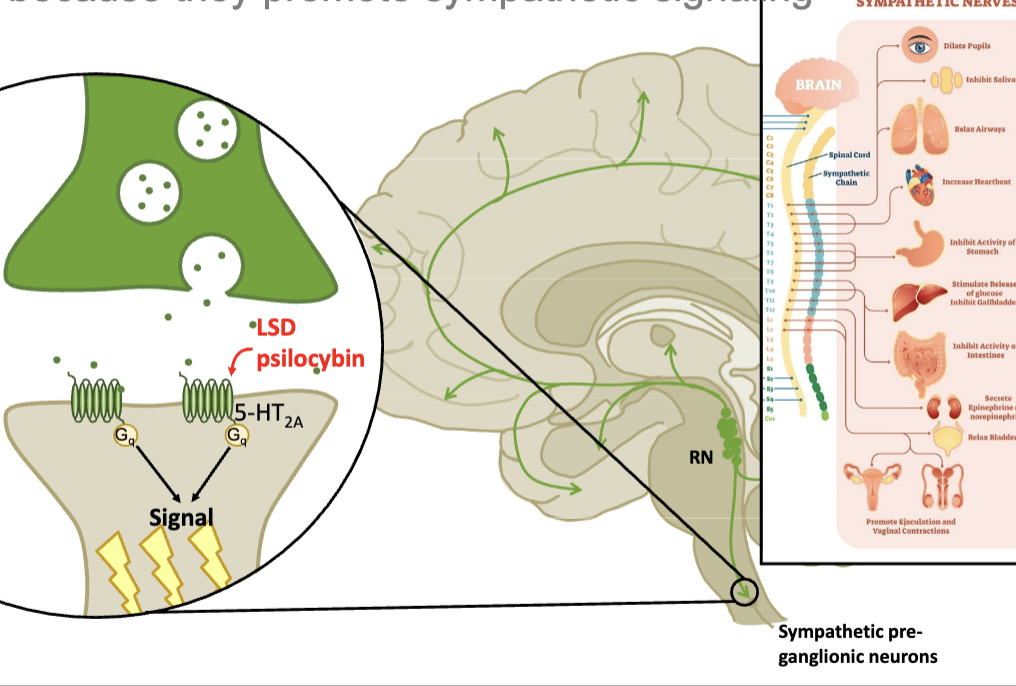PCOL:3102 Hallucinogens
1/12
There's no tags or description
Looks like no tags are added yet.
Name | Mastery | Learn | Test | Matching | Spaced |
|---|
No study sessions yet.
13 Terms
hallucinogens
drugs that alter a person’s awareness of their surroundings as well as their thoughts and feelings
two classes of hallucinogens
classic and dissociative
classic hallucinogens
increase SEROTONIN signaling
ex. LSD, psilocybin
dissociative hallucinogens
interfere with GLUTAMATE signaling
ex. PCP, ketamine
LSD
potent synthetic hallucinogen
very low effective dose (10-15 ug)
dried on paper squares, tablets, and liquid
lipid-soluble → easily gets into the brain
pharmacokinetic tolerance
in 3-4 consecutive doses, drug inactivated immediately in body but regain effects after short abstinence (3-4 days)
withdrawal and overdose rarely seen
psilocybin
magic mushrooms; a prodrug that has a long history in religious practices
high effective dose (4-10 mg)
dried/fresh mushrooms and psilocybin is a prodrug that is converted to active metabolite psilocyn
lipid soluble → easily gets into brain
pharmacokinetic tolerance
in 3-4 consecutive doses, drug inactivated immediately but regain effects after short abstinence (>week)
withdrawal and overdose rarely seen
LSD vs psilocybin
they’re pharmacologically similar and both:
are typically taken orally
resemble SER and increase SER signaling producing neuropsychological sympathetic effects
highly lipid soluble granting them easy access to the brain
subject to pharmacokinetic and pharmacodynamic tolerance
rarely associated with withdrawal or overdose
however, they’re not completely the same:
effective dose of LSD is very low compared to psilocybin
psilocybin is a prodrug converted to active metabolite psilocyn while LSD is not
psilocyn is metabolized by UGT while LSD is metabolized by CYPs
cross tolerance
resistance to a drug’s effects due to prior exposure to a pharmacologically similar drug
cross tolerance in hallucinogens
body may develop cross tolerance to multiple hallucinogens due to their similar actions at serotonin receptors
so if person takes LSD, they will be tolerant to the effects of psilocybin since both are so pharmacologically similar to each other
side effects of hallucinogens
CNS: hallucinations
sympathetic: increased HR and BP, loss of appetite, dry mouth, sweating
can cause long-term effects such as persistent psychosis and hallucinogen persistent perception disorder
how do classic hallucinogens produce their neuropsychological effects?
by activating the 5-HT2A receptors to promote post-synaptic SER signaling

how do classic hallucinogens cause sympathetic side effects?
SER neurons project all over the place and they specifically project down the brain stem which is the pre-ganglionic neurons of the sympathetic NS

hallucinogen persistent perception disorder
a trip that doesn’t end
a condition in which someone who has taken hallucinogens continues to experience visual and other perceptual distortions after quitting drug use
this can persist for weeks, months, years